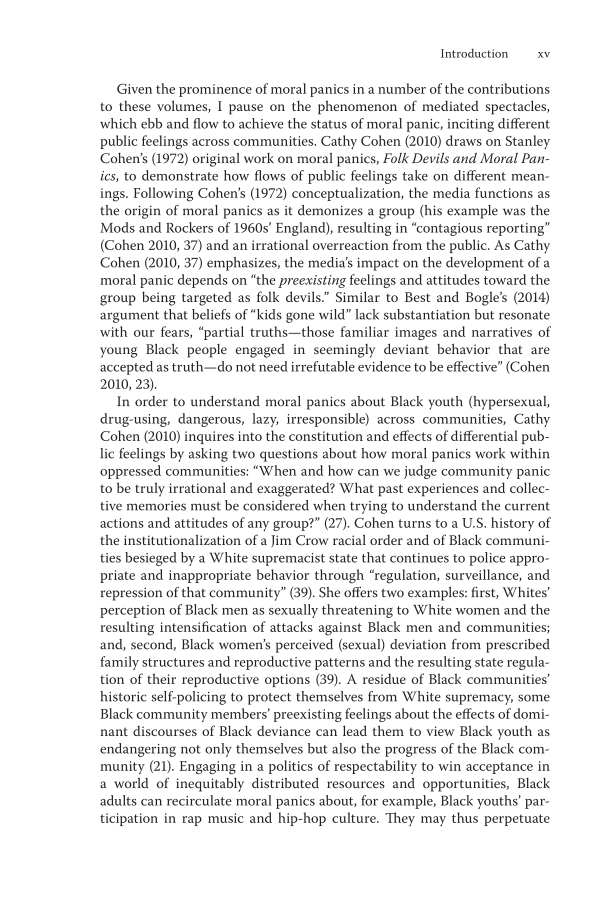Introduction xv Given the prominence of moral panics in a number of the contributions to these volumes, I pause on the phenomenon of mediated spectacles, which ebb and flow to achieve the status of moral panic, inciting different public feelings across communities. Cathy Cohen (2010) draws on Stanley Cohen’s (1972) original work on moral panics, Folk Devils and Moral Pan- ics, to demonstrate how flows of public feelings take on different mean- ings. Following Cohen’s (1972) conceptualization, the media functions as the origin of moral panics as it demonizes a group (his example was the Mods and Rockers of 1960s’ England), resulting in “contagious reporting” (Cohen 2010, 37) and an irrational overreaction from the public. As Cathy Cohen (2010, 37) emphasizes, the media’s impact on the development of a moral panic depends on “the preexisting feelings and attitudes toward the group being targeted as folk devils.” Similar to Best and Bogle’s (2014) argument that beliefs of “kids gone wild” lack substantiation but resonate with our fears, “partial truths—those familiar images and narratives of young Black people engaged in seemingly deviant behavior that are accepted as truth—do not need irrefutable evidence to be effective” (Cohen 2010, 23). In order to understand moral panics about Black youth (hypersexual, drug-using, dangerous, lazy, irresponsible) across communities, Cathy Cohen (2010) inquires into the constitution and effects of differential pub- lic feelings by asking two questions about how moral panics work within oppressed communities: “When and how can we judge community panic to be truly irrational and exaggerated? What past experiences and collec- tive memories must be considered when trying to understand the current actions and attitudes of any group?” (27). Cohen turns to a U.S. history of the institutionalization of a Jim Crow racial order and of Black communi- ties besieged by a White supremacist state that continues to police appro- priate and inappropriate behavior through “regulation, surveillance, and repression of that community” (39). She offers two examples: first, Whites’ perception of Black men as sexually threatening to White women and the resulting intensification of attacks against Black men and communities and, second, Black women’s perceived (sexual) deviation from prescribed family structures and reproductive patterns and the resulting state regula- tion of their reproductive options (39). A residue of Black communities’ historic self-policing to protect themselves from White supremacy, some Black community members’ preexisting feelings about the effects of domi- nant discourses of Black deviance can lead them to view Black youth as endangering not only themselves but also the progress of the Black com- munity (21). Engaging in a politics of respectability to win acceptance in a world of inequitably distributed resources and opportunities, Black adults can recirculate moral panics about, for example, Black youths’ par- ticipation in rap music and hip-hop culture. They may thus perpetuate
Document Details My Account Print multiple pages
Print
You have printed 0 times in the last 24 hours.
Your print count will reset on at .
You may print 0 more time(s) before then.
You may print a maximum of 0 pages at a time.
















































































































































































































































































































































































































































































































































































































